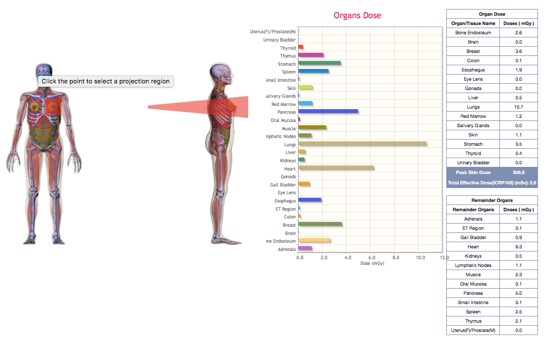(31st July 2017) —Virtual Phantoms, Inc of Albany, NY USA today announced the release of VirtualDoseIR, a tool for assessing organ dose from Interventional Radiology procedures. Like its industry-leading product for computed tomography, VirtualDoseCT, VirtualDoseIR combines a family of anatomically realistic human phantoms, advanced Monte Carlo simulations, and an easy to use web interface to provide realistic calculations of dose to a diverse patient population.
Advanced models used for organ dose simulationsVirtual Patient technology, a well-tested family of anatomically correct phantoms, advanced GPU-based Monte Carlo simulation, and innovative SaaS programming techniques, that has made VirtualDoseCT so successful. It enables users to accurately compute doses to radiosensitive organs for a broad range of the patient population, including those outside the “average” body size, pediatric patients from newborn through adolescence, and patients who are pregnant.
IR – New Tools for a growing trend
In recent years, interventional radiology (IR) procedures have expanded beyond the traditional cardiovascular applications to many other specialty areas, and so their overall use has increased significantly, today contributing more than 14% of all medical radiation dose in the US. Long exposure times can subject patients to acute injuries to the skin and other tissues, but the large accumulated doses pose a long-term radiation risk that can be monitored and managed. With continued growth, it is likely that regulatory attention will turn to IR in the future. VirtualDose provides an important tool to understanding and managing IR dose.
“We are very excited to be making this important expansion of the VirtualDose product line. When we began, CT was far and away received the most attention in terms of patient dose. In recent years, Interventional Radiology has grown in importance to the point that it has received much more focus,” said Dr. George Xu, founder and CEO of Virtual Phantoms, Inc. “We know that VirtualDoseIR will become an invaluable tool for assessing clinical practice of IR and improving patient safety.”
Useful features for clinical application
VirtualDoseIR has been designed with clinical practice in mind. Our web interface allows the user to easily select the parameters of the procedure setup, including field size, kVp, filtration, position, and direction. As these are selected, the display updates to provide a visualization of the exam field on the patient to ensure it matches the procedure performed. And because different machines may track different information, the system will accept x-ray output in terms of Dose-Area-Product or air kerma rate and exposure time (both commonly encountered measurements).
Sample display screens from the VirtualDoseIR software
About VPI
Virtual Phantoms, Inc. was founded in 2009 by faculty members from Rensselaer Polytechnic Institute, in collaboration with the University of Florida, with an exclusive license of the “Virtual Patient” technologies developed from nearly 20 years of research at RPI and UF in the field of nuclear and radiological engineering. Combining a large collection of anatomically accurate models of patients of various ages and sizes and sophisticated “Monte Carlo” simulation methods originally developed for nuclear weapons research at Los Alamos in the 1940s, VPI is recognized as a world leader in the modeling of ionizing radiation, radiation safety, and medical/occupational radiation dosimetry. For more information about Virtual Phantoms or VirtualDose, visit www.virtualphantoms.com or call or email Peter Caracappa, VPI Chief Technology Officer; +1 518-421-6931, peter.caracappa@virtualphantoms.com.
Virtual Phantoms, Inc.
1425 Central Ave. PO Box 5681
Albany, New York 12205-5681
+1 (518) 288-8048
Email: info@virtualphantoms.com





